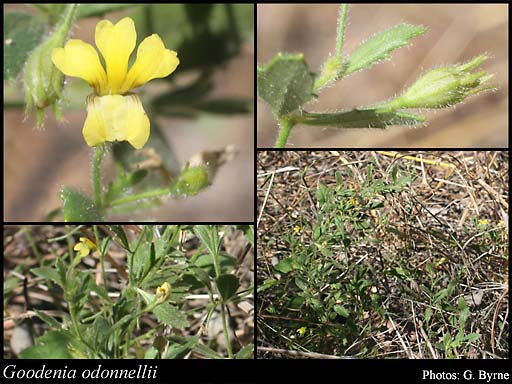- Reference
- Australas.J.Pharm. 1:278 (1886)
- Conservation Code
- Not threatened
- Naturalised Status
- Native to Western Australia
- Name Status
- Current
Often trailing, prostrate to decumbent herb, 0.1-0.3 m high. Fl. yellow, Mar to Aug. Red sand & loam. River flats & sandstone boulders.

Scientific Description
Stems ribbed. Leaves flat, 15-55 mm long, 3-20 mm wide, Indumentum present, with dense, glandular hairs; margins entire or toothed. Bracteoles present, 2-3 mm long, hairy, with simple hairs. Pedicel pedicellate, Pedicel length the pedicels 3-6 mm long, Indumentum present, Hair type with simple hairs. Calyx lobes present, Calyx length 0.5-1 mm long, hairy, with dense, simple hairs. Corolla yellow, 10-12 mm long, auriculate, not spurred, hairy on the outside, with dense or sparse, simple hairs, hairy on the inside; central lobes 2.5-3.6 mm long, with wings; outer lobes 3.9-6 mm long, wings present on both sides, 0.3-0.8 mm wide. Anthers free. Ovary inferior, not gibbose; style 5.5-6 mm long, hairy; indusium single, hairy; ovules more than two. Flowers in March, April, May, June, July and August. Occurs in the Dampier land (DL), Ord-Victoria Plains (OVP), Tanami (TAN), Victoria Bonaparte (VB), Northern Kimberly (NK) and Central Kimberly (CK) IBRA Region(s), of the Northern (N) and Eremaean (E) Botanical Province.
Distribution
- IBRA Regions
- Central Kimberley, Dampierland, Northern Kimberley, Ord Victoria Plain, Tanami, Victoria Bonaparte.
- IBRA Subregions
- Fitzroy Trough, Hart, Keep, Mitchell, Mount Eliza, Pentecost, Purnululu, South Kimberley Interzone, Tanami Desert.
- Local Government Areas (LGAs)
- Derby-West Kimberley, Halls Creek, Wyndham-East Kimberley.